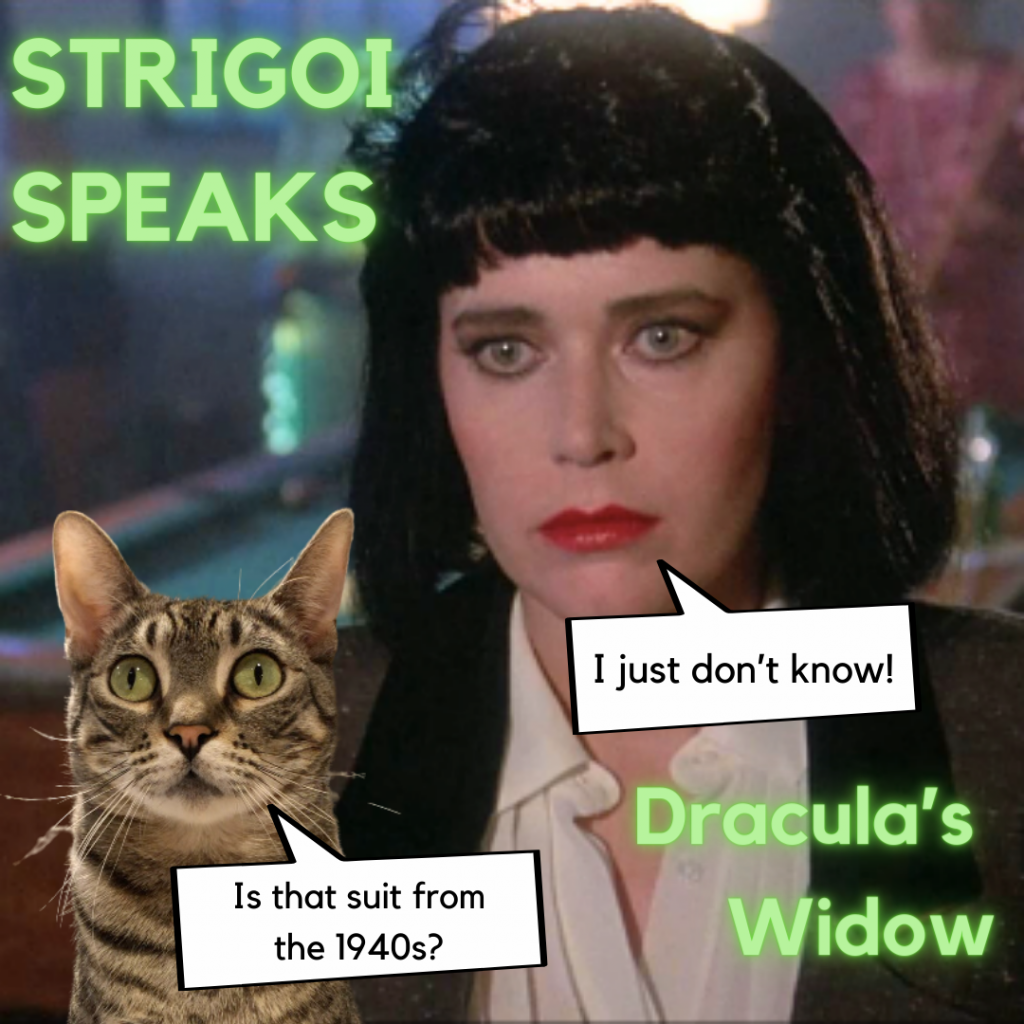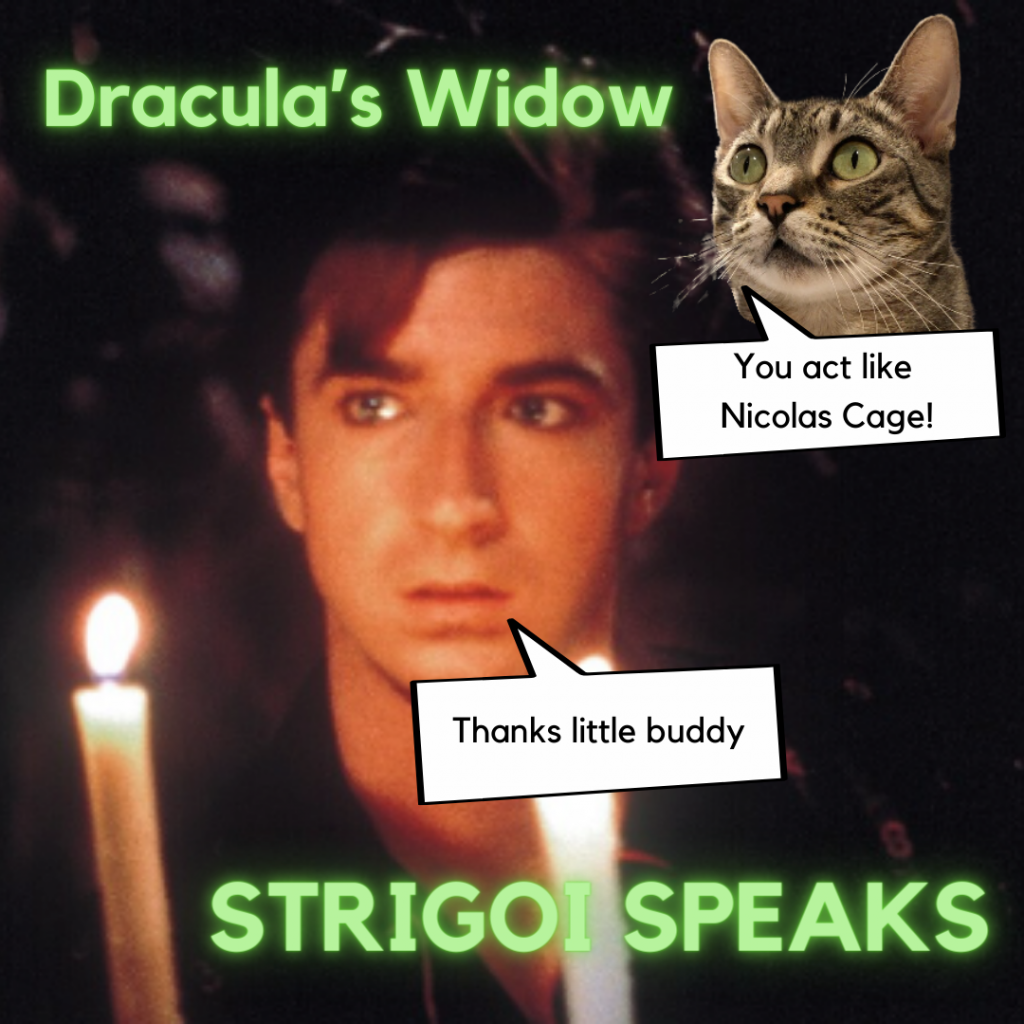

The Coppola family seems to have cornered the market on vampire films. Between Francis Ford’s blockbuster, Bram Stoker’s Dracula (1992), and Nicolas Cage’s darkly manic performance in the now cult classic Vampire’s Kiss (1988), it’s easy to forget Christopher Coppola’s low-budget horror comedy, Dracula’s Widow (1988). But I like an underdog, and this uneven effort is cleverly constructed. Emulating the big, bold style of comic books and anchored by over-the-top performances, Dracula’s Widow, like Creepshow (1982) before it, waxes nostalgic for older forms of horror entertainment. With its garish colors and abrupt cuts, it promises a filmic version of pulpy vampire fun and, for the most part, it delivers. There’s an unnecessary police angle and some questionable casting, but these flaws are easily overlooked by the fond eye of the true vampire fan. And that’s who will enjoy this movie the most. To the connoisseur of vampire literature, potentially jarring confrontations with missing context are actually invitations to co-create the story, golden opportunities for us to imagine our favorite characters in off-screen scenarios. Am I making excuses for a shoddy script? Maybe. But I enjoy productions that invite me to participate in the artistic experience; and the level of engagement afforded by Dracula’s Widow is only possible because it is not a perfect product.
Raymond is the eccentric proprietor of a horror-themed wax museum in Hollywood. Gathering props for an upcoming Dracula exhibit, he receives five boxes of Romanian antiques and an unexpected sixth crate with something he didn’t order: Dracula’s Widow! Or, less dramatic than this menacing moniker, “Vanessa,’ as she calls herself. An unwitting import who was somehow lost in the mail, Vanessa seems to have been out of cultural circulation for a very long time. She’s ignorant of Stoker’s masterpiece and shocked to hear of her husband’s death at the hands of Dr. Van Helsing. But the grief isn’t paralyzing. Soon she enslaves Raymond, destroys his romantic relationship with the insipid Jenny Harker, and attracts the attention of Detective Lannon, who is confronted with a series of brutal killings across the city. Fortunately for the police, the grandson of Van Helsing is an antique-dealing Angelino who’s eager to pick up where the legendary Doctor left off. Will law enforcement accept his help or instead pin the brutal murders on an increasingly erratic Raymond?
As this synopsis suggests, Dracula’s Widow isn’t vying for academy recognition or seeking immortality in the upper echelons of great cinema. Instead, it joyfully embraces a comic book aesthetic and explicitly aligns itself with the sensational pleasures of ephemeral art. Opening with quick cuts of the neon signage along Hollywood Boulevard, the film assaults the viewer with an aggressive strobing effect that recalls the comic book genre’s “Pow! Bam! Wham!” The dominant color is a vivid red that frequently fills the entire frame, forming a stark background against which surprised faces or extreme gore stand out. At intense moments, characters are shot from below, a technique that makes them seem larger than life and visually links them to the bold dualities of the comic book universe. Dracula’s Widow foregrounds and self-consciously celebrates old conventions in a way that feels very Creep Show, and I enjoyed the resonances between them.
Yet, while using the techniques of fast, fun, and fleeting entertainment, Dracula’s Widow is acutely aware of the history of vampire cinema and consciously–if ironically–situates itself alongside the pillars of the genre. With a projector and chair placed prominently in the center of the room, Raymond’s studio apartment is a horror cinephile’s dream, a dedicated screening space in which he sniffs wine and enjoys the classics. We watch him as he watches Nosfertau (1922); and it’s in this supremely meta moment, that we first meet Vanessa. As Murnau’s creature silently stalks, she steps before the projector, and the silhouette of her stiff posture and claw-like hands appear on the screen, supplanting Nosferatu’s iconic shadow. The message is clear: Literally stepping into the position of the world’s most recognizable vampire, Vanessa is the cinematic descendent of monster royalty and has the potential to be a cultural force in her own right.
With an introduction as visually striking as this, Vanessa the vampire should be better known among horror fans. I suspect that her lack of notoriety has to do with her name and its myriad mundane connections. In the 1980s, you couldn’t throw a rock without hitting someone called Vanessa, and their ubiquity was reflected in popular programs like The Cosby Show, Guiding Light, and Eastenders. Dracula’s widow would be more memorable if she had a lineaged name that firmly located her in the vampire tradition. Personally, I vote for the “Countess Dolingen of Graz in Syria,” a reference to “Dracula’s Guest” (1912) which, in turn, is invoking Sheridan La Fanu’s Carmilla (1872). Imagine it: If Vanessa were a reboot of the voluptuous bloodsucker who threatens Dracula’s visitor, forcing the Count to leave his castle on a rescue mission, then that would explain how the vampires met and married. This title doesn’t roll off of the tongue, but it would have given Dracula’s widow a pedigree and performed a significant amount of narrative work, providing a history for a character who’s sorely in need of one. If only screen writers would consult me. But I digress.
While there are some missed opportunities with Vanessa’s character, her clothing, affect, and body language feel completely right. Which isn’t to say that they’re good. As the widow of Dracula, she should possess a timeless beauty and exercise an easy but irresistable power. Instead, her style is a strange mix of decades that aren’t easily reconcilable with any backstory; and her movements are reminiscent of Karloff’s Frankenstein. Expecting a 15th-century Romanian gown or a Victorian negligee, I was baffled by what looks like a 1940s skirt suit, complete with seamed stockings, garter belts, and patent leather heels. Of course, it’s the clothing of the ’40s as reimagined by the ’80s, and the scrim of that decade is heavy: The shoulder pads are huge, the hair teased, the fabric cheap and synthetic. With its gaudy retro glamor, Vanessa’s outfit seems to be wearing her rather than the other way around; and her discomfort is almost palpable. If you can’t discern it in her stern features, which I think are unnaturally still so as not to destabilize her wig, then it’s communicated through her footwear which is repeatedly changed (often in the same scene!) from towering stilettos to librarian flats depending on the terrain. With her permanently hyper-extended fingers and mechanical movements, she is emphatically not the figure of feline grace that we’ve come to associate with the vampire and certainly not what we would expect of Dracula’s wife. Still, she strikes a chord in me. Maybe it’s because I remember the brutal reign of an ’80s aesthetic that seemed to demand nothing but suffering–hours in front of the mirror, Aqua Net induced headaches, and pinched toes–but I appreciate her vibe of failed sexiness and barely suppressed misery.
Everything about Vanessa is so wrong that it’s right, and the same is true of Raymond. During the opening credits, I noticed that there were two Coppola’s involved in the film–Christopher, of course, but also Marc–and wrongly assumed that the latter, whom I had never seen before, was playing the role of Raymond. Why did I jump to the conclusion that Raymond was a Coppola? Because Lenny Von Dohlen, the actor who actually plays the part, seems to be channeling Nicolas Cage, Marc’s brother. Sure, Dohlen kind of looks like a member of that famous family, but it’s more than a superficial resemblance. It’s almost spiritual, a sharing of the same ineffable presence. From Dohlen’s voice to his mannerisms, he fully embodies the weirdness of Cage and, consequently, gives a performance so strange that you can’t look away.
While I wish that Raymond had more screen time, I would happily take less of Detective Lannon. In fact, I think the movie would be better if his storyline were cut. Detective characters were wildly popular in the ’80s, but I’m bored by police procedurals and find the Columbo schtick irritating. What’s more, it’s unnecessary here. If he had lost a little less blood, Raymond–like Charlie Brewster, Sam Emerson, and so many other stake-wielding youths–could have solved the vampire problem with some help from Jenny and Helsing. In that scenario, however, Helsing would have to be played by someone more spry than Stefan Schnabel, who quite frankly isn’t sturdy enough to play the grandson of Stoker’s energetic doctor.
But who am I to retroactively alter the plot and casting! I’ll take off my director’s hat now and hope that these minor criticisms don’t detract from my larger point, which is that this deep cut from the House of Coppola has a lot to offer: It’s got great style, weird performances, and, more importantly, generative plot holes. As you may have noticed, the lacuna of Vanessa’s history (not to mention my unhappiness with her name) had me obsessively splicing story elements from across the vampire universe. I was like a writer of fan fiction, excitedly recombining old characters and settings to make something new. It was fun. By conscripting viewers into the storytelling process, tapping into their own knowledge and creativity, the film’s seemingly infelicitous gaps become the main source of its strength. I recommend Dracula’s Widow because its imperfections empower viewers and stoke their enthusiasm for the many possibilities of the genre.